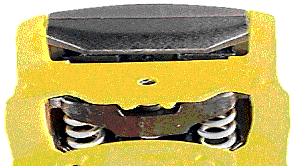BMX
Brake Systems
- Brake/Shift Levers
- Caliper Brakes (Road)
- Cantilever Brakes (MTB)
- Brake Levers
- Brake Shifter Combination Levers
- Brake Boosters
- Brake Cables
- Brake Carriers
- Brake Hangers
- Brake Pads
- Titanium Brake Hardware
Computers
Cranks and Chainrings
Forks
Frames & Framesets
Freewheels and Cassettes
Front Derailleurs
Grips
Handlebars
Handlebar Extensions
Headsets
Helmets
Hubs and Skewers
Lubricants
Metal Guide - Bicycle Metallurgy
Mirrors
Pedals and Toe Clips
Sampson Stratics Pedals
Frank's Pedal Picks
Pumps and Inflation Systems
Racks
Rear Derailleurs
Rims & Rimstrips
Saddles
Seatposts and Binder Bolts
SRP Replacement Titanium &
Aluminum parts - Master Index
Stems
Tires
Tubes
Shoes
Spokes (Tables Only)
Tables - 1998 Shimano
Tables - 2005 Shimano
Tables - Shimano
Tools - Bicycle Repair Tools
Yakima Fit List -to fit all cars
Price Information
Price Information
Shimano prices on their own page
Order Information
Ship Rates
Int'l Ship Rates
Retail Store
Archive: Review Shimano Pedals
Archive: Review Titanium Spindles
Archive: Review Suntour Pedals
Archive: Review Tioga Pedals
Archive: Review Tioga Pedals
Aluminum
Notes
Home
LOOK FAMILY OF CLIPLESS PEDALS
- An Overview


LOOK used their name recognition from the ski industry and introduced the first "toe clipless pedal", so riders could have postive contact with the pedal but enhanced freedom in the release. This style of pedal was later shortened to "clipless" by users. The LOOK cleat retaining mechanism is very simple. The cleat itself has a rounded front nose that slides into the front of the pedal under a lip, that is cast in aluminum as a part of the body. At the rear of the pedal is a locking lever that pivots backward under downward pressure. The lever is spring loaded so once the cleat is pressed past it pivots back, permitting the cleat to seat in the pedal, and then moves forward to it's original position with the top of the lever gripping the top of an exposed recess on the back of the cleat. The lever front is shaped like a blunt "V" and has a flat surface with two angled sides that center in the rear of the cleat and hold it firmly. The cleat is shaped with inclines on the rear sides that slide against matching inclines in the lever, so that small movements in the foot force the cleat to center in the pedal again. But when there is a large movement by the cleat, it pushes past where the two inclines slide against each other, to the flat front of the lever so the cleat and shoe slide laterally out and away from the bike.
The inclined surfaces on both the cleat and the pedal exaggerate the foot and cleat movement. Again, from a small movement, the system will continue to retain the cleat but a sharp or large movement obligates it to go all the way to release the rider's foot. But how does it work? The rear lever pivots on a rod at its base. The lever piece is molded of plastic and this rod is driven through one side of the pedal, then through the lever and into the other side of the pedal, allowing it to rotate on the rod like an axle. Inside the hollow cast lever on it's bottom plate, there are two cylindrical holes 10mm in diameter spaced 32mm apart. In these cylindrical holes a strong 10mm in diameter coiled steel spring stands vertically. These vertical springs apply downward pressure on the bottom of the interior in the lever that forces it to pivot around the rod (axle) so the top of the lever grips the top of the cleat at the rear. But how is the adjustment accomplished? On the top of the two vertical springs is a plastic plate that spans the width of the inside cavity with recesses for the top of the springs. This plate sitting on the top of the springs has a steel nut firmly built into it, with the tension adjusting screw passing through this nut. As the tension adjusting screw is turned in the "+" direction, increasing the tension on the spring, this plate is pushed down from the top on the two springs to increase the amount of force they apply the pivoting rear clamping lever, which holds your pedal more firmly to make release more difficult. Loosening this bottom screw, turning it in the "-" direction, causes the plate to move up, applying less tension on the spring making release more likely with less pressure. Though LOOK sells several models of their pedals, many of the models use exactly the same spindle and bearing assembly. The spindle is cold forged of steel then chrome plated. Afterward plating, grinding and polishing are done on the area of the spindle that the bearings revolve. At the threaded end of the spindle, LOOK has a molded Black plastic lock nut which threads into and closes off the pedal body. Moving from the outer Black plastic piece to the inner bearings, there is a precision sealed thrust bearing cartridge that's held in place with a cir-clip behind it. The main length of the spindle is supported inside the body by a pressed-in needle bearing that has twelve rollers. The exposed, threaded end of the spindle has a 6mm allen fitting to make installation easier. There are two body forgings for the LOOK road pedals; the Pro-Shape, which is slightly narrower with three complete radiused lines in front of the rear clamping lever, and the Bio-Shape which has one narrow and one broad radiused line in front of the rear clamping lever. The Pro- Shape body is cast with a 32 degree lean angle, meaning the bicycle can tilt up to 32 degree from vertical and not have pedal to ground contact - or is said to have 32 degrees of lean. The Bio-Shape body will permit up to 30 degrees of lean before the pedal contacts the ground. All LOOK road pedals use one of these two forgings with slight variations in the material used for the clamp/lever. LOOK ships their pedal sets with two different pair of cleats and one set of mounting hardware in the box. One pair is the type originally used with LOOK pedals, is Black and holds the cleat in the pedal in a fixed position, permitting no lateral rotation though the foot can be moved up to 4 degrees and re-centered without going into the pre-release phase where the cleat begins to move backward the rear lever. The other set of cleats is known as the ARC (anatomical red cleat) cleat and is Red in color. The ARC cleat permits up to 9 degrees of lateral movement from the center of the pedal. LOOK is able to achieve these two release styles on the same pedal by changing the shape of the lip At the rear of the cleat gripped by the clamping lever. The Black cleat is made to exactly contour the front of the clamping lever, while the Red cleat bows out in the middle leaving a hump to run against the flat face of the rear lever. Additionally, the inclined sides on the cleat that mate to the inclined sides on the pedal are made wider apart permitting the lateral play in the cleat. LOOK makes their mountain bike pedal cleats smaller and lighter than the road cleats. They are still made in the Black and Red colors, and the colored cleats still have the same purpose. The weight reduction occurs from the removal of all the excess plastic material that is still required on their road cleats, because the three bolt fastening system, to the cycling shoe. The mountain cleats are in every respect the functional equivalent to the road cleats, but have the front toe lip piece narrowly connected to the rear lip that the clamping lever holds. Lastly, if you read a LOOK brochure you will note that their published weights are lower than ours, however we actually weighed a production pair on a digitally accurate scale, while prototypes may have been used to derive their weights.

